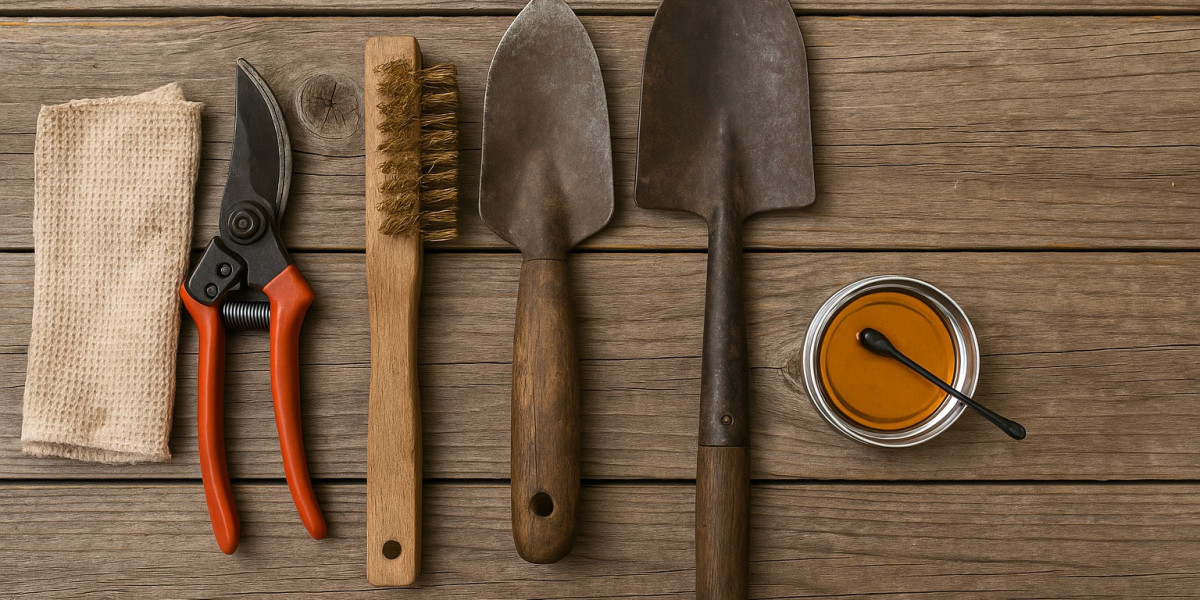Gardening is more than planting and watering; it is an ongoing dialogue with nature that relies heavily on the tools in your hands. A well-cared-for tool set makes the work easier, safer, and far more enjoyable. Yet many gardeners neglect maintenance until rust appears, handles splinter, or blades lose their bite. Just like your plants thrive with consistent care, your tools require a structured schedule to remain reliable. Setting up a weekly, monthly, and yearly plan ensures your gardening tool set stays in peak condition and saves you money in the long run.
Why a Structured Maintenance Schedule Matters
Garden tools must withstand a variety of conditions, including plant sap, filth, moisture, and harsh treatment. If these components are not maintained, they might corrode, break, and even cause accidents. A suitable schedule:
Extends tool lifespan and protects your investment.
Reduces the risk of plant diseases spread through dirty blades.
With proper upkeep, your gardening tool collection transforms from disposable goods into enduring companions for your gardening endeavours. The moment may be opportune to acquire a gardening tool set that suits your gardening scale and level of maintenance, whether you are just starting out or already have a full kit.
Weekly Care: Small Steps with Big Impact
Weekly care involves quick checks and gentle cleaning. These small tasks prevent major issues later.
Cleaning After Each Use
After every session, remove soil from blades, tines, and handles. A stiff brush works well for metal parts, while a damp cloth is suitable for smooth wooden handles. Residual moisture is a silent enemy, creating rust within days. Air-dry tools completely before storing them in a dry place.
Sharpening Minor Edges
Blades of hand pruners, hoes, and shears dull quickly when used daily. Running a sharpening stone or file across them once a week keeps them precise. Sharp tools reduce strain on your hands and produce cleaner cuts that heal faster on plants.
Quick Lubrication
Apply a light oil coating to moving parts, such as pruner joints or shear springs. This prevents stiffness and avoids the grinding that prematurely wears down tools. Even something as simple as cooking oil can be effective, although mineral oil is often preferred for its longevity.
Weekly Handle Check
Handles bear much of the strain. Look for cracks, splinters, or loose screws. Addressing these issues promptly can prevent accidents, such as snapped handles during use. A quick sand with fine-grit paper can smooth splinters before they worsen.
Monthly Maintenance: Deepening the Care
Where weekly tasks are about surface care, monthly attention digs deeper. It is the stage where you check not only usability but also safety.
Disinfection Against Diseases
Tools that come into contact with plants may carry spores, bacteria, or viruses. Once a month, disinfect blades with a solution of diluted bleach or isopropyl alcohol. This small habit prevents cross-contamination that can ruin entire beds.
Sharpening with Detail
While weekly sharpening maintains an edge, a monthly deep sharpening gives tools a razor finish. Gardeners often use specialised sharpening kits or diamond-coated files. Shears, loppers, and spades benefit most from this step.
Checking Fasteners and Bolts
In tools with moving parts, tighten the nuts, bolts, and screws. A working tool might become dangerous due to misalignment or fracture caused by a loose fastener. Unexpected shocks are avoided with monthly checkups.
Protective Coating for Metal and Wood
Tools can have their lifespan significantly increased by applying a thin coating of linseed oil or rust inhibitor. Oiling wooden handles also prevents them from drying out and breaking.
A survey conducted by gardening merchants found that neglected handles are responsible for more than 60% of tool breakages, which serves as a stark reminder of the significance of monthly maintenance.
Yearly Maintenance: Preparing for the Long Haul
Once a year, preferably at the end of the growing season, tools deserve thorough attention. This stage resets them for the challenges ahead.
Full Inspection and Replacement
Examine each tool thoroughly. Replace worn-out components, such as screws, springs, or even handles in their whole. If repairs cost more than they are worth, some tools might have to be retired. Take advantage of this chance to improve your set.
Rust Removal and Restoration
For tools showing signs of rust, use a wire brush, sandpaper, or a rust remover. If pitting is severe, consider professional restoration. Tools restored properly can last another decade.
Deep Storage Preparation
Before storing tools for winter, clean them meticulously, sharpen edges, oil every surface, and wrap delicate parts in cloth or paper. Store them upright or hanging in a dry, ventilated shed.
"Tools, like friendships, grow stronger with consistent care and weaken when ignored."
Calibrating and Balancing Specialized Tools
Gardeners who use mechanical or advanced tools such as sprayers or hedge trimmers should schedule annual calibration. This ensures accuracy, efficiency, and safety for the coming season.
The Role of Storage in Tool Longevity
The effort can be undone by careless storage, even with careful cleaning. Tools that are kept outside or in moist areas quickly deteriorate. Toolboxes, dry shelters, or wall-mounted racks keep them safe and well-organized. Moisture accumulation is decreased in storage spaces with adequate ventilation. The tool care page of the Royal Horticultural Society offers helpful guidance on protective surroundings in greater detail.
Specialized Tools Require Specialized Care
Not all garden tools fall into the same category. Some require unique handling.
Power Tools
Electric trimmers, mowers, and blowers should be checked for frayed cords, faulty switches, and clogged vents. Cleaning and storing them properly reduces fire risks. Consult manufacturers’ manuals for yearly servicing.
Cutting Tools
Pruners, secateurs, and saws are the most infection-prone. Regular disinfection and careful sharpening reduce plant disease transmission. Specialised sharpeners for curved blades improve their performance.
Soil Tools
Spades, hoes, and forks face high impact. Inspect their weld points, look for bending, and ensure they are not weakened by rust. Soil sticks less to polished, oiled surfaces, making cleaning easier.
Preventive Practices that Save Time
Prevention is always more effective than cure. Small habits make large differences.
Avoid using tools for unintended purposes, such as using a spade as a lever or a pruner as a wire cutter.
Keep an organized workspace where tools can dry and remain accessible.
Gardeners who follow systematic tool maintenance report 40% fewer replacements and increased overall gardening efficiency, according to research from the University of Minnesota Extension.
FAQs
How often should I sharpen my gardening tools?
Light sharpening weekly and a thorough sharpening monthly is ideal. It ensures tools remain safe and efficient.
What oil is best for wooden handles?
Linseed oil is widely used because it penetrates wood fibers, preventing cracking and extending handle life.
Is bleach safe for disinfecting tools?
Yes, diluted bleach is effective, but it should be rinsed off and tools dried immediately to avoid corrosion.
Do power tools require the same maintenance as hand tools?
No, power tools require additional care such as electrical checks, filter cleaning, and sometimes professional servicing.
Should tools be stored indoors during winter?
Yes, storing them in a dry, frost-free environment is essential to prevent rust and damage.
A Living Relationship with Your Tools
There is more to a maintenance routine than just oiling wood and cleaning metal. It's about developing a bond with the very tools that help to create your garden. They remain nimble, dependable, and prepared for every assignment that comes their way thanks to weekly, monthly, and annual practices. Well-maintained tools pay it forward by making gardening easier and more satisfying.
Your tools become more than just objects as you cultivate this rhythm of care; they become your gardening friends. They will become quiet witnesses to times of work and happiness, bearing with them the memory of each seed sown and harvest harvested. You'll notice the difference regular upkeep makes the next time you pick up a sharp pruner or polished spade.








